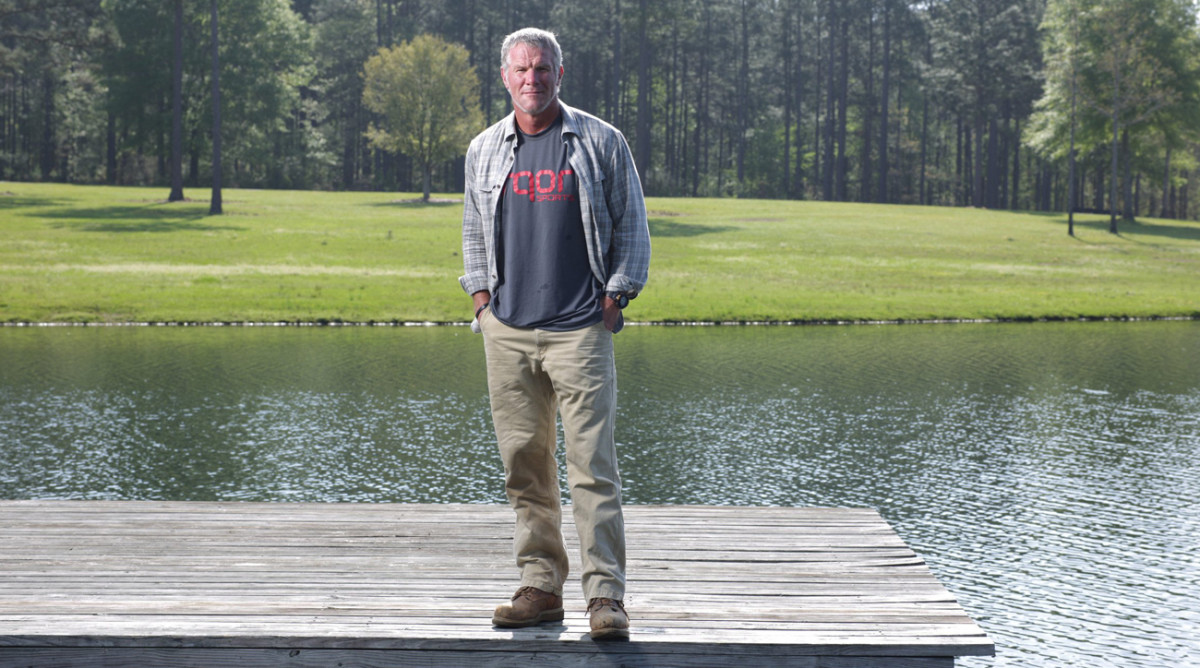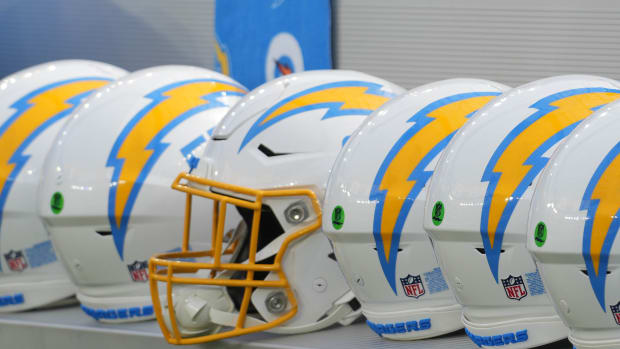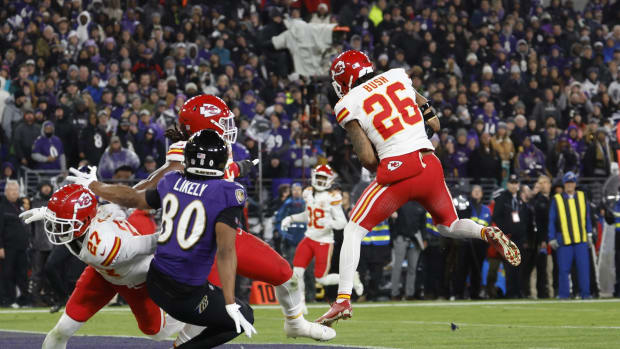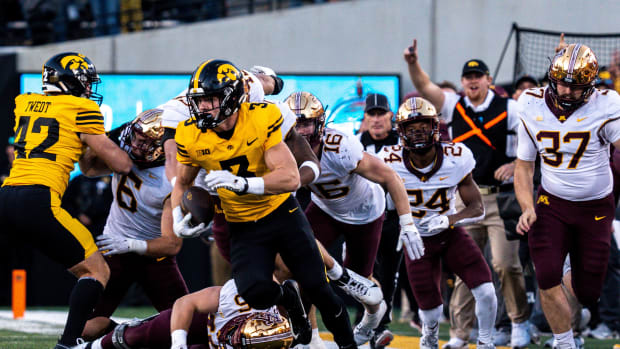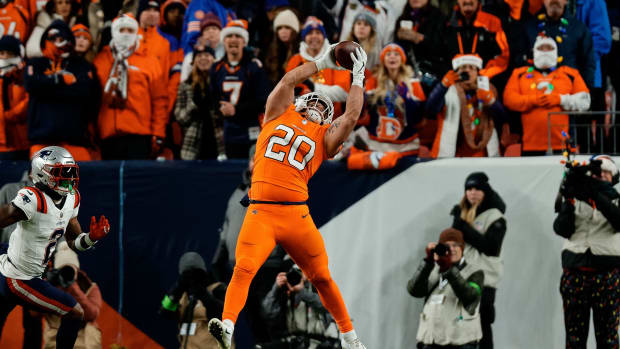Brett Favre, Concussion Victim, Is Backing Research into a Concussion Drug
On the last play of Brett Favre’s football career, he suffered a concussion. In the seven years since his retirement, the Hall of Fame quarterback has become increasingly honest regarding his concerns about the long-term consequences of the sport through which he made his name.
There are times Favre will run into someone he knows on the Southern Miss campus whose name he just can’t place, and he wonders if it’s old age, regular forgetfulness or something else. He was “speechless” upon hearing about the research study published this summer in the Journal of the American Medical Association, which found the degenerative brain disease chronic traumatic encephalopathy in 110 of 111 deceased NFL players whose brains were donated for research. Favre has three grandsons now, and he says definitively that he’d much rather caddy for them in golf than watch them from the stands playing football.
“Playing 20 years and not missing a game in 19 of those is a great thing, but I can’t believe that it’s going to do anything good for my long-term health,” Favre says. “And there’s not a day goes by—of course, the news that I hear periodically doesn’t help—but there’s not a day that goes by that I don’t wonder...”
That nagging fear and his simultaneous love for the game of football have led Favre to invest both his money and his name into the development of a drug to treat concussions. With increasing pressure for more and better solutions for the problem of traumatic brain injuries in football and beyond, pharmaceuticals are perhaps the next frontier. There’s education and changing behaviors; there’s prevention, through rules changes or better equipment; and there’s more accurate and thorough diagnosis. But after diagnosis, right now, the only recommended “treatment” for a concussion is rest until symptoms resolve, and a gradual return-to-play protocol.
Much has been learned over the last several years, and much is still yet to be learned, about the mechanism of concussions. Scientists describe a cascade that takes place at the cellular level following trauma to the brain. Researchers have homed in on ways to slow or stop this cascade in nerve cells, mitigating the short-term—and potentially long-term—effects of brain injury, though there’s no drug yet that has been proven to work in this way in humans.
Will New CTE Findings Doom the NFL Concussion Settlement?
There’s a public health need in finding a way to treat concussions, helping kids and adults return to school or work and everyday life. But it’s also so relevant to the future of football that some of the biggest stars in the game, like Favre, are backing efforts to find a concussion treatment. Within the past few months, Favre says he’s talked with the NFL’s new chief medical officer, Allen Sills, about a drug being developed by a Florida-based pharmaceutical company, Prevacus, in which Favre is an investor.
“Bad news is building, so something has to be done, and it needs to be done quickly,” Favre says. “If we come up with a drug that will treat concussions, maybe guys get back on the field more quickly, but more importantly maybe we don’t have these conversations about present players 20 years down the road, like Tony Dorsett, and Junior Seau, and on and on.”
A few years after he retired, Favre was introduced to Jake VanLandingham, a neuroscientist at Florida State who created Prevacus to spearhead the development of a concussion drug. The drug, intended to be administered nasally within minutes after diagnosis of a brain injury, is a neurosteroid designed to work by stimulating three different gene promoters in brain cells that turn on cellular survival mechanisms to reduce swelling, inflammation, oxidative stress and cell death (all examples of trauma at the cellular level that are linked to both short- and long-term neurological impairment). It has shown promising results in rats, in improving short-term memory, motor function and anxiety after a brain injury, but the next step will be clinical trials to test its efficacy in humans.
Favre helped recruit other NFL greats to Prevacus’s sports advisory board, including Kurt Warner, Matt Hasselbeck, Steve Mariucci and Eddie DeBartolo Jr. Having the backing of big NFL names does not say anything about the drug’s usefulness; it is, though, a reflection of the heightened awareness and urgency around brain injuries in football. Other prominent NFLers are aligned with other potential concussion treatments. Seahawks cornerback Richard Sherman, for example, is on the board of Oxeia, another pharmaceutical company working on a synthetic molecule targeting the metabolic dysfunction in brain cells after concussion (Chris Nowinski, co-founder of Boston University’s CTE Center, is an advisor). Meanwhile, the University of Miami is undertaking a five-year study on the application of CBD, a cannabinoid derivative of hemp, in combination with an anesthetic to treat concussions.
Clinical trials are expensive, and so some tie to the NFL can be key to moving the ball forward. There’s also a source of possible funding in the NFL’s $100 million Play Smart, Play Safe initiative, $40 million of which was earmarked last year for neuroscience research. Initial applications for that funding opened this fall and were due Oct. 31; a panel of six doctors and scientists will oversee a three-part selection process in which they’ll rank the best proposals researching issues such as diagnostics, treatments and the short- and long-term effects of brain injuries. In early 2018, the NFL will award the funds, committing up to a $20 million grant for each winner over the next three to five years.
‘I Feel Lost. I Feel Like a Child’: The Complicated Decline of Nick Buoniconti
Any potential drug to treat concussions would not only have to be safe for human use, but also prove its effectiveness through a clinical trial on human patients who have been diagnosed with concussions (the results in lab animal models in many cases do not translate to humans). Also, if a drug is shown to improve short-term recovery from concussion, that doesn’t necessarily prove anything about the long-term impact, though it would nonetheless be a big step forward. A faster return to play shouldn’t be a risk so long as a drug is addressing the underlying physiology of a concussion and resolving symptoms faster, rather than simply masking them.
Poll an NFL locker room in 2017, and every player knows the current routine for how to handle a concussion. “Rest,” says Eagles receiver Torrey Smith, who finished last season on injured reserve after he suffered a concussion in a Week 14 game. “There is also something very natural that can treat concussions as well,” another player says, in a sly reference to the potential of CBD, or medical marijuana. But the idea that a concussion could be treated with medicine right at the stadium, as if you were taking an antihistamine for an allergy attack, is a foreign concept right now. “Really?” Smith says. “If that’s something that existed, there’s no doubt it would be beneficial, because there are concussions every week in this league.”
There’s no proven solution yet, but there is both a need and an opportunity to change the way concussions are addressed. Says Vernon Williams, sports neurologist at the Kerlan-Jobe Institute and a consulting team physician to the L.A. Rams, “This represents a long-awaited shift in terms of concussion management. For years the default position for concussion was watchful waiting. … If there was some hope and optimism related to the potential to treat symptoms in the short term, and to prevent long-term effects, it would have a significant effect on elite athletes and, frankly, on some questions and concerns parents have about letting their kids play.”
Finally content in retirement, Favre preps for his next Lambeau moment
Around the time he was introduced to VanLandingham and Prevacus, Favre was contacted by a different research group at a university to see if he’d like to participate in experimental (and later debunked) brain testing he was told could check for permanent neurological damage. Favre declined, because even if the scan did show something, there would be nothing he could do to fix it; it would be too late. That’s partly why lending his support to the development of a concussion treatment appealed to him. If there were a way to address the problem when it happens, perhaps a future generation would not have to wonder like he does.
Kalyn Kahler contributed reporting.
SIGN UP FOR THE MMQB NEWSLETTER. Get “The Morning Huddle” delivered to your inbox first thing each weekday, by going here and checking The MMQB newsletter box. Start your day with the best of the NFL, from The MMQB.
Question or comment? Email us at talkback@themmqb.com.
































